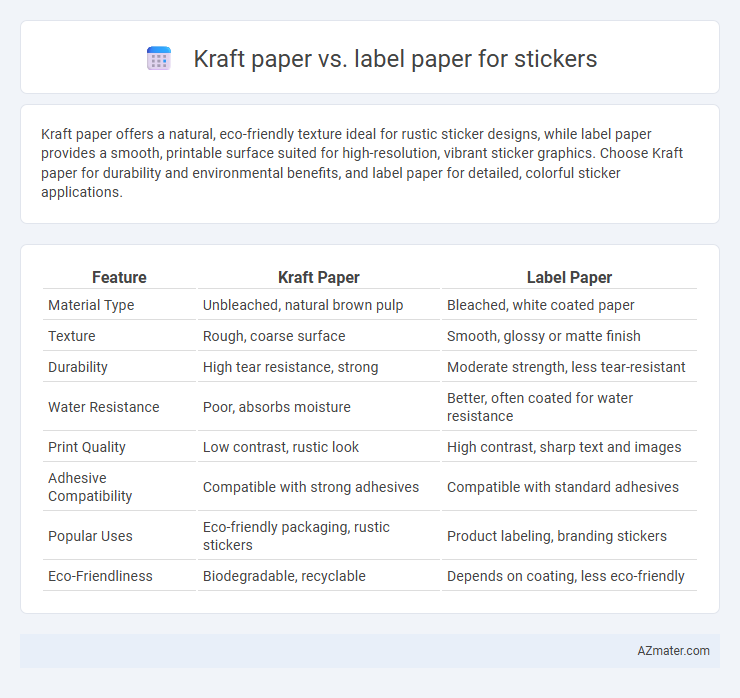Kraft paper offers a natural, eco-friendly texture ideal for rustic sticker designs, while label paper provides a smooth, printable surface suited for high-resolution, vibrant sticker graphics. Choose Kraft paper for durability and environmental benefits, and label paper for detailed, colorful sticker applications.
Table of Comparison
| Feature | Kraft Paper | Label Paper |
|---|---|---|
| Material Type | Unbleached, natural brown pulp | Bleached, white coated paper |
| Texture | Rough, coarse surface | Smooth, glossy or matte finish |
| Durability | High tear resistance, strong | Moderate strength, less tear-resistant |
| Water Resistance | Poor, absorbs moisture | Better, often coated for water resistance |
| Print Quality | Low contrast, rustic look | High contrast, sharp text and images |
| Adhesive Compatibility | Compatible with strong adhesives | Compatible with standard adhesives |
| Popular Uses | Eco-friendly packaging, rustic stickers | Product labeling, branding stickers |
| Eco-Friendliness | Biodegradable, recyclable | Depends on coating, less eco-friendly |
Introduction to Kraft Paper and Label Paper
Kraft paper is a durable, coarse paper made from wood pulp featuring natural brown tones that provide a rustic, eco-friendly appearance ideal for artisanal sticker designs. Label paper offers a smooth, white or glossy surface designed specifically for high-quality printing, ensuring vibrant colors and sharp text for stickers used in branding and product labeling. Both materials vary in strength, texture, and print compatibility, influencing their suitability for different sticker applications.
Key Differences Between Kraft and Label Paper
Kraft paper is a durable, natural brown material known for its strength and eco-friendly properties, commonly used for rustic or vintage-style stickers, while label paper is smooth, glossy or matte, designed to provide a clean, professional finish with strong adhesive qualities. Kraft paper offers a textured, organic look suitable for craft or artisanal branding, whereas label paper ensures high print clarity and vibrant color reproduction ideal for detailed graphics and product labeling. The key differences lie in material texture, durability, print quality, and aesthetic appeal, influencing their application in sticker production based on branding and functional needs.
Pros and Cons of Kraft Paper for Stickers
Kraft paper for stickers offers a rustic, eco-friendly appearance with strong durability and excellent tear resistance, making it ideal for artisanal or organic product labeling. However, its porous surface can absorb ink unevenly, potentially reducing print clarity and color vibrancy compared to smoother label papers. Kraft paper is more suitable for matte, muted designs but may not perform well in high-moisture environments or require high-definition printing.
Pros and Cons of Label Paper for Stickers
Label paper for stickers offers superior print quality and vibrant color reproduction, making it ideal for detailed and eye-catching designs. However, it tends to be less durable and more prone to tearing or peeling compared to kraft paper, especially in outdoor or rough handling conditions. Its smooth surface enhances adhesive performance but may lack the rustic, natural aesthetic provided by kraft paper.
Print Quality Comparison: Kraft vs Label Paper
Kraft paper offers a rustic, textured surface that absorbs ink differently, resulting in muted colors and a vintage aesthetic, ideal for eco-friendly or artisanal sticker designs. Label paper provides a smooth, glossy or matte finish that yields sharp, vibrant print quality with precise detail, making it preferable for high-resolution images and professional branding. Print clarity and color vibrancy are significantly higher on label paper, while kraft paper's print quality is favored for its organic, tactile appearance.
Durability and Adhesion: Which Paper Performs Better?
Kraft paper offers excellent durability with a rugged texture that resists tearing and withstands outdoor conditions, making it suitable for rustic or heavy-duty stickers. Label paper, typically coated and smoother, provides superior adhesion on a variety of surfaces, ensuring stickers remain firmly attached without curling or peeling. For scenarios demanding strong adhesive performance on smooth surfaces, label paper outperforms kraft paper, while kraft paper excels in durability under rough handling and environmental exposure.
Aesthetic and Design Considerations
Kraft paper offers a rustic, natural aesthetic with a textured, earthy brown tone that enhances vintage or eco-friendly sticker designs. Label paper provides a smooth, glossy or matte finish ideal for vibrant colors, sharp details, and professional branding on stickers. Choosing between these materials depends on the desired visual impact, with kraft paper emphasizing organic appeal and label paper supporting precise, high-quality print designs.
Sustainability and Eco-Friendliness
Kraft paper offers superior sustainability compared to label paper due to its natural, unbleached fibers that are biodegradable and recyclable, reducing environmental impact. Label paper often contains synthetic coatings and adhesives that hinder recyclability and contribute to microplastic pollution. Choosing kraft paper for stickers supports eco-friendly packaging by minimizing carbon footprint and promoting compostable waste management.
Cost Analysis: Kraft Paper vs Label Paper
Kraft paper offers a cost-effective option for sticker production due to its lower material and manufacturing expenses compared to label paper, which often involves pricier coatings and finishes. Label paper typically provides higher quality printing and durability, but these benefits come at a premium price, increasing overall production costs. For large-volume projects, Kraft paper reduces per-unit cost significantly, making it ideal for budget-conscious applications where premium appearance is not critical.
Choosing the Best Paper for Your Sticker Project
Kraft paper offers a natural, rustic look with strong durability, making it ideal for eco-friendly or vintage-inspired sticker projects that require a textured finish. Label paper provides a smooth, glossy or matte surface, enhancing color vibrancy and detail resolution for professional-quality stickers used in branding and packaging. Choosing the best paper depends on your sticker's purpose, desired aesthetic, and required durability, with kraft paper favored for artisanal appeal and label paper recommended for high-definition graphics and easy application.

Infographic: Kraft paper vs Label paper for Sticker
 azmater.com
azmater.com